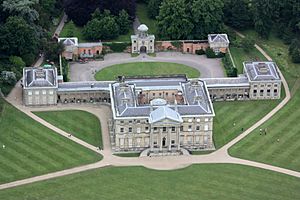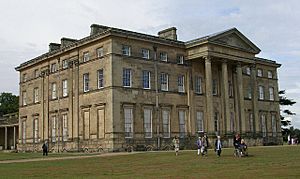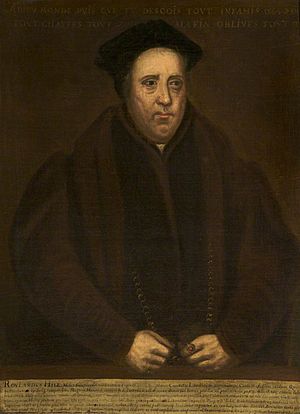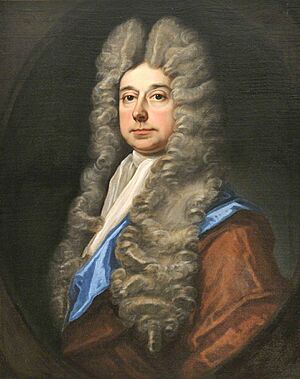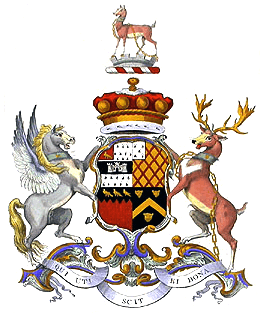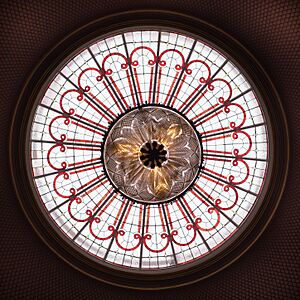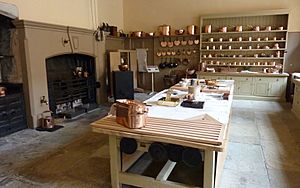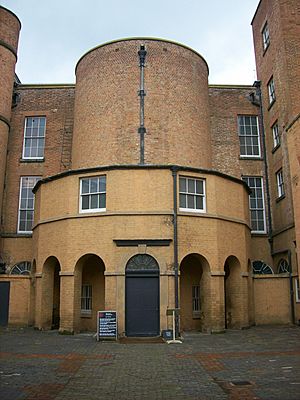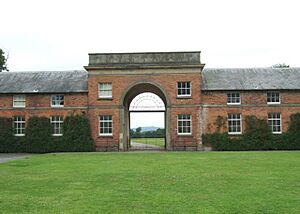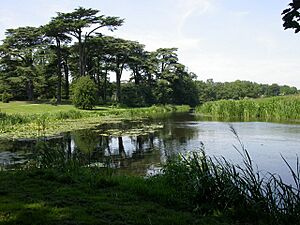Attingham Park facts for kids
Quick facts for kids Attingham Park |
|
|---|---|
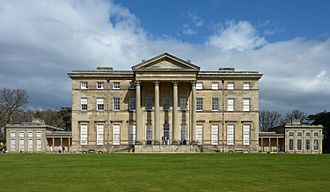
The entrance front, Attingham Park
|
|
| General information | |
| Type | Stately Home |
| Architectural style | Neoclassical |
| Location | near Atcham, Shropshire, England |
| Completed | Finished 1785 |
| Owner | National Trust |
| References | |
|
Listed Building – Grade I
|
|
| Reference #: | 1055094 |
Attingham Park is a beautiful English country house and large estate in Shropshire, England. It's located near the village of Atcham, close to the B4380 road that connects Shrewsbury and Wellington. Today, the National Trust owns and cares for Attingham Park, which is a very important historical building, listed as Grade I.
The main house at Attingham Park was built in 1785 for Noel Hill, 1st Baron Berwick. It replaced an older house called Tern Hall. Lord Berwick used money he inherited to hire an architect named George Steuart. Steuart designed a grand new house that completely surrounded the old Tern Hall. Once finished, the new country house was named 'Attingham Hall'.
The entire Attingham Estate covers about 4,000 acres (about 1,600 hectares). The parkland and gardens alone are huge, covering 640 acres (about 260 hectares), and are also historically important. In 2022/23, over 560,000 people visited Attingham Park, making it the most popular National Trust property.
Within the park, there are five other important buildings. These include the old stable block, the Tern Lodge toll house (which you can see from the B4380 road), and two bridges that cross the River Tern. There are also 12 other listed structures, like the estate's retaining walls, the bee house, the ice house, the walled garden, and the ha-ha (a hidden ditch that keeps animals out of the garden).
Contents
A Long History at Attingham
Ancient Times and Roman Life
Attingham Park has a very long and interesting history, with signs of people living there for about 4,000 years. People first settled here during the Bronze Age, using the rich soil for farming.
The estate has seven ancient monuments, including an Iron Age settlement. There are also Roman forts and a large part of Viroconium, which was one of the biggest Roman cities in Britain. This Roman city was located near the village of Wroxeter. Recent surveys have even found two Roman villas and a cemetery, along with evidence of Iron Age or Roman-British farms. You can also find traces of old Roman roads to the west of Wroxeter.
Archaeologists have also found remains of Anglo-Saxon palaces, including two rare 25-meter-long timber halls from around 650 AD. This shows that a large and important Anglo-Saxon community lived in this area.
The Medieval Village and Manor
By the Middle Ages, there was a village called Berwick Maviston on the estate. This village no longer exists, but you can still see the remains of a moat and fish ponds from the old manor house. This manor and village were mentioned in the 1086 Domesday Book, a famous survey from the time of the Norman Conquest.
The original medieval manor eventually fell into disrepair. Another house, known as 'Grant's Mansion', was recorded on the site in 1790. The village of Berwick Maviston was lived in until the 1780s. When the first Baron Berwick built Attingham, he moved the village from his land. The title of Baron Berwick actually comes from the name of this old village.
The Hill Family Arrives
The Hill family's connection to the Attingham area goes back a long way. Sir Rowland Hill, an important Tudor statesman, built the first stone bridge over the river here. He was known for his public projects in London and Shropshire. A portrait of him is still displayed in the mansion today.
Before the current mansion was built, a building called Tern Hall stood on the site. It was designed by a relative of Richard Hill of Hawkstone, who was also related to Sir Rowland Hill.
The Barons of Berwick and Attingham
Attingham Park was the main home of the Barons Berwick from the 1780s until 1953. When Thomas Henry Noel-Hill, the 8th Baron Berwick, passed away in 1947 without children, he generously gave the Attingham Estate to the National Trust. He wanted the house and its contents to be kept as a great example of 18th-century architecture.
Attingham Park was designed by George Steuart and built between 1782 and 1785 for Noel Hill, 1st Baron Berwick. Lord Berwick was a Member of Parliament for Shropshire and received his title in 1784. The house has a large entrance courtyard with an impressive gatehouse. Two single-story wings extend from the main building. The main rooms were divided into areas for men and women on opposite sides of the house.
In 1789, the 1st Lord Berwick passed away, and his son, Thomas Noel Hill, 2nd Baron Berwick, took over. Thomas loved collecting art and made improvements to the house and estate. He hired the famous architect John Nash in 1805 to add the picture gallery. This gallery was designed with cast iron and curved glass to let in lots of light. In 2013, work began to build a new protective roof above Nash's delicate glass roof to prevent leaks and protect it from weather. This new roof also has temperature control and UV-resistant glass.
The 2nd Lord Berwick faced financial difficulties, and many of the house's contents were sold in 1827 and 1829. He passed away in Italy in 1832. His brother, William Noel-Hill, 3rd Baron Berwick, then inherited the estate. William was a diplomat who lived in Italy for 28 years. He collected Italian art and furniture, which became part of Attingham's collection. This included beautiful tableware by the silversmith Paul Storr.
William passed away in 1842, and his younger brother, Richard Noel-Hill, 4th Baron Berwick, inherited. As the youngest son and a clergyman, he hadn't expected to inherit. His son, Richard Noel Noel-Hill, 5th Baron Berwick, inherited in 1848. He was very careful with the estate, making farming more modern and paying off many of the family's debts. He lived at Cronkhill on the estate and even invented a type of rifle called the Cronkhill rifle.
Richard was followed by his brother, William Noel-Hill, 6th Baron Berwick, in 1861. He was an army colonel and chose not to live at Attingham. William passed away in 1882, and his nephew, Richard Henry Noel-Hill, 7th Baron Berwick, inherited. The 7th Baron also had money problems and sold family treasures to pay off debts. He passed away in 1897.
Attingham in the 20th Century
Thomas Henry Noel-Hill, 8th Baron Berwick (nephew of the 7th baron) inherited the estate. He was a diplomat who worked in France and added French decorative arts to the Attingham collection. He also had electricity installed in the house and made other improvements to the estate.
During the First World War, the 8th Lord Berwick allowed the Van Bergen family to live at Attingham. They helped set up a hospital for wounded soldiers there. The hospital opened in October 1914 and by 1918 had 60 beds and an operating theatre. Lord Berwick served as a diplomat in Paris during the war. He married Teresa Hulton in 1919. Teresa had worked with Belgian refugees and as a Red Cross nurse. The couple worked hard to restore the house.
During the Second World War, Edgbaston Church of England Girls' School was moved to Attingham and lived in part of the house. Later, the Women's Auxiliary Air Force also stayed there.
Attingham Joins the National Trust
In 1937, discussions began with the National Trust. In 1947, the 8th Lord Berwick left Attingham Park to the National Trust in his will. He wanted the house and estate to be preserved as a great example of 18th-century architecture, with its rooms looking as they would have for a nobleman of that time.
Attingham Today: Learning and Conservation
The Attingham Trust and Country House Studies
From 1948 to 1976, the Shropshire Adult Education College used the hall. In 1952, the Attingham Trust was created. Its goal was to give American museum curators a chance to learn about British country houses. A summer school has been run by the Attingham Trust every year since 1952. It now includes many different country houses across the United Kingdom. The Attingham name is now known worldwide, with groups like the American Friends of the Attingham Trust (founded in 1962) and the Attingham Society (founded in 1985). These groups help members stay in touch and continue learning about British country houses.
Restoring and Protecting Attingham
Until the 1990s, most of Attingham was closed to visitors. From 2000 to 2016, the National Trust ran a special project called Attingham Re-discovered. During this time, conservation experts worked on the house while visitors watched. Rooms were also re-decorated to look as they once did. Big projects included replacing the carpet in the Picture Gallery and adding a new roof in 2012. In 2014, visitors were even asked to help identify what needed to be conserved in the house.
Attingham is now a main center for the National Trust in Herefordshire, Shropshire, and Staffordshire.
Estate Buildings and Gardens
The estate has a walled garden and an orchard. They grow fresh produce that is used in the tearooms and sold to visitors. The walled garden is a rare example from the Georgian period. A restoration project began in the 1990s, and by 2008, 25% of the garden was being used for growing again. The orchard has 37 different kinds of fruit trees.
Attingham is also home to one of only two surviving Regency bee houses in the country. The Attingham bee house was built in 1805. It has a slate roof to keep the beehives dry and special lattice work that allows the bees to fly in and out easily.
Attingham's Stables were built at the same time as the main house for the first Lord Berwick. They were designed by Steuart and placed near the house's entrance to show off the family's good taste and wealth.
Parkland and Wildlife
The Attingham Estate covers about 4,000 acres (1,600 hectares). In the early 1800s, it was even bigger, at 8,000 acres (3,200 hectares). The large 640 acres (260 hectares) of parkland and gardens are very important historically.
The park was designed by the famous landscape architect Humphry Repton. It includes woodlands and a deer park. In 2018, about 180 fallow deer lived in the park.
The River Tern flows through the middle of the estate and joins the larger River Severn just south of the Tern Bridge. The rivers were important to the estate. In the 1700s, ironworks on the Tern helped the family's wealth. Fish from the rivers were also an important resource for food and recreation.
The park is a special area called a Site of Special Scientific Interest (SSSI). This is because it is home to many rare kinds of invertebrates (animals without backbones). About 470 acres (190 hectares) of the park are SSSI areas. The amount of deadwood from fallen trees in the park makes it a perfect home for many different species, especially beetles. Some of these beetles are adapted to live on ancient trees.
In 2005, a survey of the plants in the park found 68 species that had not been recorded in a previous survey from 1969–72.
Cronkhill Villa
Cronkhill is a nearby Italian-style villa on the estate. It was designed by the architect John Nash for the 2nd Lord Berwick, around the same time as the Picture Gallery. The first person to live there was the estate's land agent, Francis Walford. Cronkhill is located on a hillside overlooking the River Severn valley and the Wrekin hill. The National Trust owns the villa, and it is privately rented. It is open to visitors on a few days each year.
See also
- Hawkstone Hall
- Soulton Hall
- Grade I listed buildings in Shropshire
- Listed buildings in Atcham


